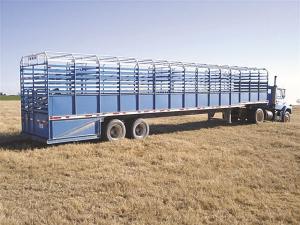2010 - Volume #34, Issue #1, Page #16
[ Sample Stories From This Issue | List of All Stories In This Issue | Print this story
| Read this issue]
Home-Built Cattle Hauling Livestock Trailer
 |
 |
"We like how it turned out and the cattle load really easily. We get a lot of positive comments from people who see it," says Bradley, who worked on the project alongside his father, John, and uncle, Robert.
Bradley says it took just over a year to build the unit, as they fit the project in around other farming duties.
To form the floor of the trailer, they used 3 and 4-in. channel iron, with cross pieces spaced about 1 ft. apart. Rubber tongues and groove flooring goes over the top. It's 2 in. thick and 7 in. wide.
"In each compartment, we installed cleats to keep the cattle from slipping. To do this, we welded together a series of 1-ft. squares, using 5/8-in. oil field sucker rod. The whole thing is hinged to the wall on each side, but it's not connected down the center of the floor, so you can lift each side up and lean them against the trailer wall to allow easy access for scraping out the floor with a scoop shovel. The last thing we do is pressure wash it out, so we can get it quite clean."
"The upright posts were made with used 1 1/2-in. oilfield tubing, and we framed the exterior with 5-in. channel iron all the way around. For the bottom 2 ft. of the walls, we welded on 12-ga. sheet metal with a 1-in. lip bent at the top of it," Bradley explains. "Above the sheet metal, we put on 1 by 3-in., 16-ga. rectangular tubing, gradually increasing the spacing from 3 1/2 in. to 5 in."
He says they also used the lightweight 1 1/2-in. oilfield tubing to make the bows over the top, by welding pieces together that formed two 22 1/2 degree angles on each side.
Inside, the rig has a 10-ft. long compartment at the front, followed by two 15-ft. compartments (each with its own gate).
The compartment gates are designed in such a way as to create a corner of protection when they're open, for a person inside while cattle are being unloaded. On the driver's side of the trailer, there's a 1-ft. fence section, then a 4-ft. gate hinged to the remaining 3 1/2-ft. fence (for each of the compartments.) When the 4-ft. gate swings open, it creates a safe triangular standing space because it hits the opposite trailer wall.
At the back of the trailer, the floor drops down 2 1/2 ft. where there's a 6-ft.-long "box" which is what makes the trailer into a "ground-load" unit. The floor of the box is 17 in. off the ground - the same as a regular stock trailer.
However, inside the box, the Veitenheimers installed an aluminum ramp, salvaged from an old double deck semi trailer. It needed some modification to make it fit, but it already had lugs on it for traction. The ramp allows the cattle easy entrance to the three upper compartments. It's hinged on one wall, so when the rest of the trailer's full, the Veitenheimers just pull it up out of the way, and latch it before loading animals into the final 6-ft. "box" compartment.
The trailer has double gates on the back, and all the corners on the gates are made with the two 22 1/2 degree angles on each side, to make it look nicer, according to Bradley.
The unit is 102 in. wide, which is the standard width of a truck, and has a capacity of about 25 mature cows. The family has hauled up to 47 yearlings with it, according to Bradley.
The project cost the Veitenheimers roughly $10,000 in materials. Other than the used chassis, oilfield sucker rod and pump barrel pipe tubing, the rest of their supplies were bought new.
"It's nice to have because we don't need a loading chute," he says. "We can load anywhere that a stock trailer can load. Although most semi trailers can haul a lot more cattle, most of them require a loading chute, too. Something similar to this sold new, commercially, would cost $35,000 to $36,000, and it wouldn't be built as well."
Contact: FARM SHOW Followup, Bradley Veitenheimer, 363 Frances Dr., Windthorst, Texas 76389 (ph 940 631-2500; altabradgen@comcell.net).

Click here to download page story appeared in.

Click here to read entire issue
To read the rest of this story, download this issue below or click here to register with your account number.




